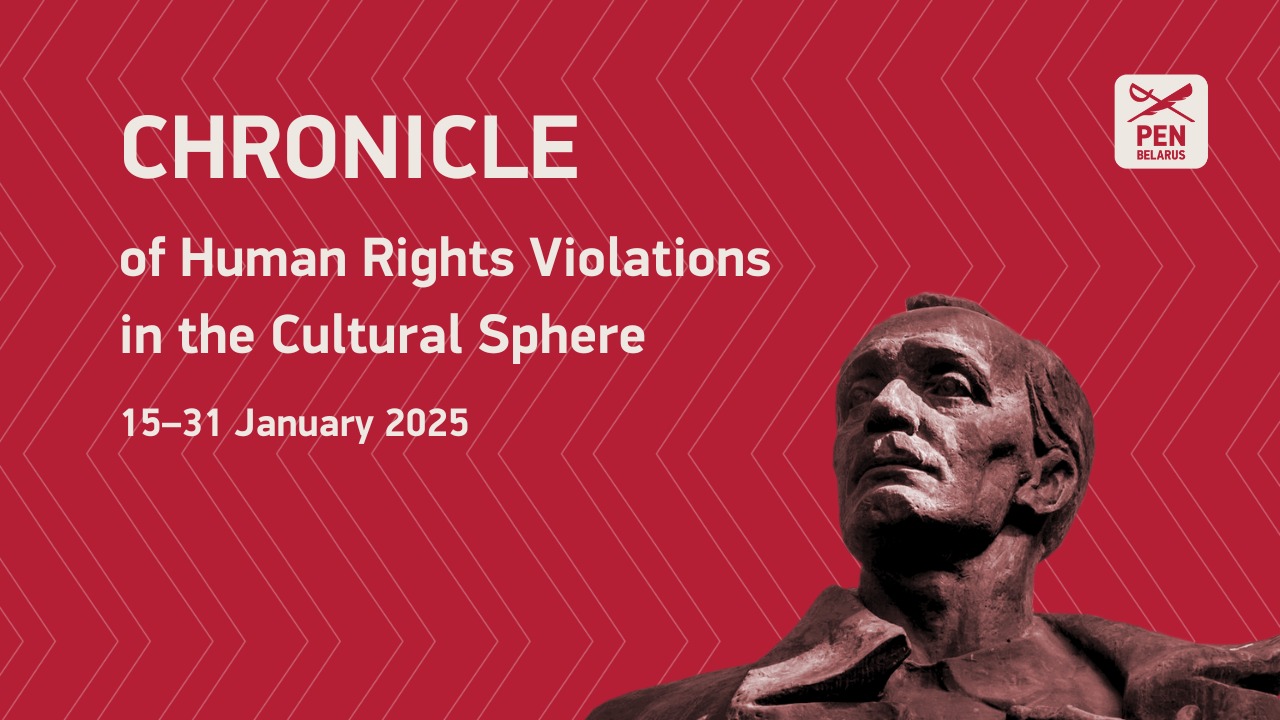
As of 31 January 2025, at least 168 cultural figures, including not less than 37 People of Word, were not free – behind bars or in home confinement.
The trial has begun in a new criminal case against political prisoner Michaił Łabań, who created accessories for members of historical reenactment groups.
A criminal case was opened against Belarusian language populariser Ihar Słučak.
The criminal trial of vocal competition laureate Daniel-Landsey Keita has started.
Designer Natalla Zacharava-Pranhišvili was tried for “violating election legislation.”
Thirty new titles were added to the list of literature prohibited for distribution.
The court declared the social media accounts of the “Kabylaki. Executed in Orša” initiative run by the relatives of the victims of Stalinist repressions as “extremist.”
Maryja Bułavinskaja’s Forest, a documentary film about Stalinist repressions, was added to the list of “extremist materials.”
I. Criminal prosecution of cultural figures, authors, and performers
1. On 22 January, Minsk’s Maskoŭski District Court began hearing the criminal case against Daniel-Landsey Keita under Part 1 of Article 342 of the Criminal Code (organizing or actively participating in group actions that grossly violate public order). Daniel-Landsey Keita is a first-degree laureate of the Feodor Chaliapin National Contest for Young Vocalists and a third-degree laureate of the Feodor Chaliapin International Contest. He was detained in June 2024 in Hrodna.
2. On 29 January, the Viciebsk Regional Court began hearing a new criminal case against political prisoner Michaił Łabań. He is charged under Article 361.2 of the Criminal Code (financing the activities of an extremist formation). Michaił Łabań owns the jewellery workshop “Samarodak,” where he created jewellery for members of historical reenactment groups. He was detained on 17 February 2022 and charged under Article 369 of the Criminal Code (insulting a government official), Article 368 of the Criminal Code (insulting the President of the Republic of Belarus), Article 367 of the Criminal Code (defamation of the President of the Republic of Belarus), and Article 361.2 of the Criminal Code (financing the activities of an extremist formation). At a closed trial in Navapolack on 20 May 2022, he was sentenced to four years in a minimum-security penal colony and fined 100 base units.
3. On 30 January, it became known that a criminal case had been initiated against Belarusian language promoter Ihar Słučak. He shared this information on his Facebook page. Ihar Słučak is accused under Part 2 of Article 361.4 of the Criminal Code (facilitating extremist activity). It is known that the criminal case was opened on 22 May 2024. Ihar Słučak has been living outside of Belarus since 5 October 2023.
ІІ. Detentions and administrative trials
On 28 January, designer Natalla Zacharava-Pranhišvili was tried in Minsk’s Leninski District Court under Article 10.9 of the Code of Administrative Offences (violating the legislation on elections, referenda, or the exercise of citizens’ right to legislative initiative).
III. Conditions in the places of incarceration
On January 30, information about the prison conditions of Łarysa Ščyrakova surfaced. Human rights defender Leanid Sudalenka shared details provided by a woman recently released from the colony: “Łarysa was immediately transferred from quarantine to Unit No. 17, known as the ‘sewing unit.’ This means the entire unit works in two shifts, sewing light camouflage winter jackets for the internal troops. In other words, all the uniforms for guards at Belarusian prisons, pre-trial detention centres, and penal colonies are made by imprisoned women. Unit No. 17 is known as ‘red’ (a term for units fully loyal to the administration), where regular inmates openly cooperate with prison officers and are willing to carry out any task or stage provocations against political prisoners for a pack of cigarettes. There are about 7–8 political prisoners in these units.”
Łarysa Ščyrakova is a journalist, local historian, documentary filmmaker, promoter of Belarusian history and culture, performer of folk songs, re-enactor of traditional rituals, and coordinator of a memorial project honouring victims of repression, The Murdered and Forgotten. On 31 August 2023, the Homiel Regional Court sentenced her to 3.5 years in a penal colony and a fine of 3,500 rubles ($1,386) under Article 369.1 of the Criminal Code (discrediting the Republic of Belarus) and Article 361.4 of the Criminal Code (facilitating extremist activity).
IV. Repressions in the book sector
On 24 January, the National Commission for the Evaluation of Symbols, Attributes, and Information Products reviewed books that “could harm national interests if distributed.” Thirty (30) new titles were added to the Ministry of Information’s list of literature banned for sale. The list now contains 65 publications, including books dedicated to the history of Belarus.
V. Monopolization by the state of the right to define the content of historical memory
1. On 23 January, a court in Orša declared the social media accounts of the “Kabylaki. Executed in Orša” initiative as “extremist.” The initiative unites relatives of victims executed in the forest on Kabylaki Hill near Orša and focuses on collecting information about those repressed during the Soviet era.
2. On 29 January, Homiel’s Central District Court included Maryja Bułavinskaja’s film The Forest about Stalinist repressions in the list of “extremist materials.” The film is based on testimonies of victims of Stalinist repressions and witnesses of executions.
